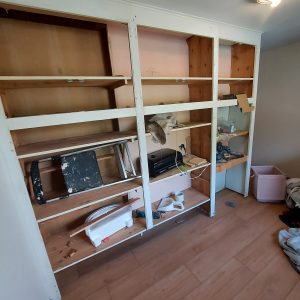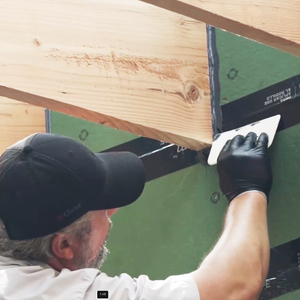Hanging shelving from ceiling joists
Hello homebuilders, I’ve recently had to tear out a bit of rotted subfloor that had shelving sitting on it.
To remove the flooring, subfloor, and replace, I cut the legs free, leaving the shelving hanging by the ceiling.
The shelves are old. Not sure the species of wood, but the nails are hand driven finish nails, something between an 8&16.
Anyway my question is how much weight do you think this system can take, and what would be the best(easiest) way to beef it up without putting legs down, or, should I just put the legs back down.. pictures below.



















Replies
I think I'd screw some 2x4 blocks under some of the shelves and maybe a few screws through the dividers.
It's not the shelves individually I'm worried about.
It's the 1x3 nailed into the ceiling that 1x8 dividers are hanging from. Placing more screws into the ceiling covers the pull out. But how much weight can these 1x8s hold with nails only in the final 3/4 of the wood before the nails simply pull through the grain?
Do you think fully hanging it from the ceiling is prudent, or should 45° kneeouts be added in do you think?
Again, if you place a 2x4 under the shelf and screw the divider to the 2x4 I think you'd be okay. Also, aren't the shelves attached to the dividers?
If the shelving is well painted in, and unloaded, they'd probably stay in place anyway.
But I'm trying to load them with them hanging. Without putting legs back down. I'm a framer, not a cabinet builder.. but a2x4 runner along the wall would only support the back pack, it's a 14" wide shelf consisting of 2 1x8s.. perhaps I'm misunderstanding you
No, sorry I think I misunderstood you.
I was thinking temporary and you are talking permanent.
Okay, I would change to something like a 1x2 under the shelves (all) and use construction adhesive where applicable.
Sorry for the confusion
Do you know which way the ceiling joists run?
I would want to get into as many as possible with screws at least an inch into solid wood. Cabinet screws would work. I would not want to rely on finishing nails. They will pull out sooner or later.
angle iron with holes from the local home improvement store can help, depending on the geometry.
Where you have wood cleats that you can screw solidly into the ceiling joist, the connection to the vertical board needs to be upgrade to screws at least.
It looks like most of the load will be on the face frame. are you going to put the doors back on?
Another thing to consider is running threaded rod down behind the front boards, assuming you can get the top load hooked into the joists.
If you want load these up with your rock collection, or boxes full of books, it would be simpler to get some feet back to let the floor carry the load.
Permanently hang book shelves from the ceiling? Are you kidding? Do you have no concept of the weight of books? Have you never moved a box of books? A 3 foot run of shelving could easily be 75 lbs, maybe 100 lbs. 6 shelves floor to ceiling would be 450-600 lbs.
I pulled up my subfloor just to reinforce the joists with cross members. The joists were 1 ft on centre, and ran parallel to the bookcase. Didn't want the OSB sagging over time.
Are you aware how many children are killed or severely injured by bookcases and even dressers that tip over when they try to climb them?
You might be childless and simply want to display your exotic bird feather collection but the next homeowner might have different ides.
Words can't express how shocked I am at the idea and that even UncleMike42 hasn't called you out on this.
What can I say, I just woke up from my nap.
You can beef up the brown vertical boards and secure then to the wall (if a stud is handy) As well as beef up the attachment to the ceiling (studs above)
as well as support from above.
The best way is if you have access to an attic above. look for framing connectors that provide threaded connections, and run threaded rod through the ceiling, behind the face frame, and attach to the vertical front boards, as well as a couple shelves.
https://s3.amazonaws.com/finehomebuilding.s3.tauntoncloud.com/app/uploads/2016/04/09120911/021256082-lateral-load-connector-main.jpg
Something like a secure deck ledger connection, but turned on end.
https://www.strongtie.com/resources/product-installers-guide/dtt2z-installation
Rated for 1500#
My previous suggestion of a screw into the stud has limitations.
https://www.engineeringtoolbox.com/wood-screws-allowable-withdrawal-load-d_1815.html
a single screw is only good for 100# on a good day. (but this is enough to secure bookshelves or dressers into the wall to keep the tykes safe)
What can I say? I had just got up from my nap. If this site had signatures, mine would include a quote, "Free advice is worth what you pay for it (sometimes)."
Suburbanguy has the right idea, to start with requirements, and an estimate of how much the shelves might be expected to take over the lifetime, and that putting the legs back in would likely be the best idea.
If you can get to the top of the ceiling joists (from an attic above), you could use some framing connectors designed to secure a threaded rod, and use that to support the load. (coupled with securing vertical boards to the wall)
deck connectors are designed to handle something like 1500# in tension (check the specs). you could estimate a screw into the joist to hold 100# in tension (depending on length of thread into the wood, and screw size/thread).
Am I missing something here, or is there some reason why you can't place blocks/strips/brackets under each shelf and screw those into the wall studs behind?
I make custom shelf brackets that are simply a length of dimensional (it varies depending on shelf depth/weight) running along the wall with another sticking straight out; basically a T-shape. E.g. for a 8" deep shelf, I use a length of 1x8 flat against the wall, on/into the stud, with another piece of 1x8 7 1/4" long coming straight out from it (held to it w/adhesive and 6" screws driven straight through the back), so the end is flush with the end of the shelf. (For shelves holding heavy items I use 2x lumber, and put one on each stud.) So for shelves 15" deep, I'd use maybe a 2x6 or 2x8, with the back strip being 8 - 10" long and the actual shelf support being 13.5" long.
It might sound odd, but it actually looks pretty cool when installed--I've attached a photo of a shelf I put up in my younger daughter's room--and it holds shelves just fine, especially as I then drive a screw or two through the shelf into the bracket, as well. You could certainly place an angled piece instead, or a proper metal shelf bracket.
Is there some reason why you can't do that, or something similar, here? It even looks as if there are a few brackets/braces in a few spots.
I've used those metal angles from the hardware store to hold up shelves, too, as was previously suggested.
Also, do you need the shelves to *be* floating, or do you just want them to *look* floating? A 2x placed in the back along the wall will at least offer some support to that part of the unit, and it won't be visible from the front--you could probably get another one under there about halfway back, and it will still not be visible.
Sorry if I'm missing something/am totally off base here, I'm just not sure why you can't anchor the shelves into the studs (or even just with heavy-duty drywall anchors) if you want the unit to be floating, instead of trying to figure out how to suspend it from the ceiling.